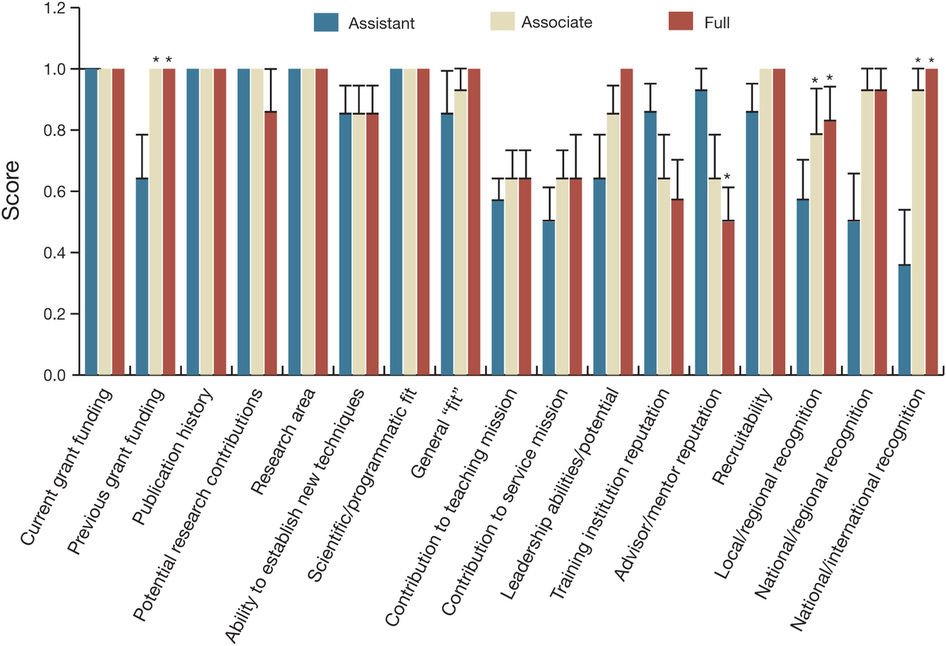By Maggie Kuo
Science, October 2, 2017 —

David Werbrouck on Unsplash
In the tenure-track faculty job hunt, status counts. Some of the factors that a hiring committee at a research-intensive university valued most in an assistant professor candidate included whether they had published in big-name journals and the reputations of their institution and adviser, according to a small survey that was published last month. Bringing grant funding to the department was another top consideration, which the authors dubbed a “core competenc[y]” based on the survey responses. Teaching and service were deemed “unnecessary credentials,” while having earned previous funding—for example, a doctoral or postdoctoral fellowship—was found to be slightly more important.
The results, though not surprising, offer a reminder that, with so many people vying for so few tenure-track faculty positions, “trainees need to do more self-analysis of where they are and what the realities are for them to potentially become a faculty member,” says study author Nathan Vanderford, an assistant professor of toxicology and cancer biology and assistant dean for academic development at the University of Kentucky in Lexington. The sooner trainees realize they may need to consider other options, the sooner they can start preparing for those jobs and move forward with their careers, Vanderford adds.
For those who still want to pursue the research-university faculty path, the survey results—which echo other studies finding that candidates who get faculty jobs tend to come from elite departments and publish in high-impact journals—may help them formulate a strategy. For example, the focus on publications is in line with recommendations from Karen Kelsky, a former anthropology professor who now runs a coaching service for students and postdocs pursuing academic careers. She finds that applicants often write cover letters that are too long and filled with emotion-related statements, such as “I am passionate about” or “I strongly believe in.” She advises her clients to write concise cover letters that focus on research outcomes in terms of published peer-reviewed articles. “Any other focus is going to harm them [rather] than help them on the job market,” she says.

Committee emphasis on faculty credentials changes with career stage. Credential scores were compared among assistant, associate and full professor career stages by one-way ANOVA with post hoc Tukey test. Data are represented as mean ± s.e.m.; *P<0.05, **P<0.01. Source: Nathan Vanderford
While a clear-eyed view of the current status quo is useful, the results also highlight some of the potential problems with this system. Current practices can hinder diversity in the professor ranks, says Joan Herbers, professor emeritus of evolution, ecology, and organismal biology at The Ohio State University in Columbus. For example, women are underrepresented in top doctoral programs. “When search committees really value that kind of pedigree, they are introducing some gender issues without even thinking about that,” she says. Herbers wouldn’t be surprised if other research-intensive institutions had similar mindsets to what Vanderford’s small survey found. “The focus on pedigree is entrenched,” she says.
So, although some responsibility lies with trainees to take charge of their careers and be realistic about the faculty job market, the authors of the study also offer some recommendations about how some of the problems with the current hiring system could be addressed. De-emphasizing name recognition—of candidates’ advisers, institutions, and the journals they publish in—can broaden the pool of candidates who get hired, the authors write. Some ways to move in this direction include eliminating journal impact factor as a criterion and removing identifying information from cover letters, they continue.
Although academia can seem set in its ways, getting committees to change their hiring practices is possible, says Jessi Smith, professor of psychology at Montana State University in Bozeman, who developed a faculty-search strategy that increased the number of female faculty members hired. The strategy included unconscious bias training for the hiring committee, a guide for recruiting diverse candidates, and connecting candidates with a faculty member outside of the search committee to answer their questions about the university’s work-life balance. Other committees were eager to adopt the techniques when they saw her data, Smith notes. They wanted to have a diverse applicant pool and to hire candidates that would have long careers with the department, she says. “I think faculty welcome change, but somebody has to show you how to do it.”











